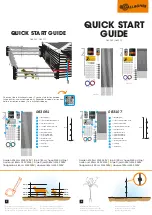
16
STEP-BY-STEP
GUIDE
0800 003 006
/
boundaryline.co.nz
Wear the appropriate
safety equipment for
performing the task.
Eye wear, hearing
protection & a dust
mask.
Wear the appropriate
safety equipment for
performing the task.
Eye wear, hearing
protection & a dust
mask.
CUTTING THE PANELS
CUTTING THE POSTS
POST EXTENSIONS: FOR ALL WALLS WHERE EXTRA POST LENGTH IS REQUIRED
The panels can be cut using a circular saw with a timber
blade. Remember to always support or catch the piece
you’re cutting off as it may break towards the end of
your cut if you don’t.
Note - If your circular saw doesn’t have a deep enough
blade to cut through the panel in one sweep then you
must cut through one face and carefully turn the panel
over and cut through the other.
The panel should go 25mm into the rebate of each post.
Example: If the distance between the internal face
of posts is 2000mm then the panel should be cut at
2050mm.
Mark the post and use a 5 inch/125mm angle grinder
with a 1mm cutting blade to cut through the post. A
smaller grinder (4 inch/100mm) can be used but you
will find it difficult to get the blade depth required when
cutting through the rebate in the post that accepts the
panel.
Note: All cut edges that will remain exposed to the
elements will require treating with a zinc rich paint such
as ‘cold gal’ or similar.
Where a post extension is required the 2 halves must be flexed open and sleeved over the exterior
of the post base by 200mm minimum, then fastened with the supplied tek screws at a minimum
100mm spacings along the flange edges (see picture below).
We recommend digging your hole first, then measuring the depth of the hole and sleeving the post
extension onto the base of the post to suit the hole depth.
Before panel insertion the post must be core filled with concrete to cover the post extension
internally.
NOTE: -
The pictures below are only showing one half of the post extension being fitted, the post
should be turned over and the other half fitted also.
The 2 halves of the post extension will not quite meet in the middle of the post, this is to allow a
small amount of concrete to enter the centre of the post before actual core filling.
!
IMPORTANT
!
IMPORTANT
Examples: Unstable ground, gate support posts or wind region C etc.
ADDITIONAL
INFORMATION



























